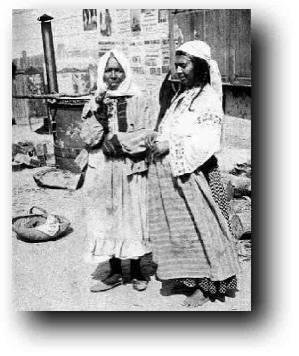| It is necessary when describing Romani customs
and traditions to explain some important points that may clarify some facts
presented. Most of the customs and traditions expressed in this section
refer to those observed by the older European Roma groups, except where
noted.
The Romani population has been a composite one
from the very beginning, with different ethnic groups brought together
during their initial great migration from India. The Romani population
and the Romani people came into being outside of India, though the various
ethnic elements began inside India. This is supported linguistically and
increasingly more on the basis of history. For the extensive amount of
Persian and Byzantine Greek influence upon the Romanes language, members
of the migration out of India stayed in these areas long enough for this
to occur, and they no doubt brought members of those populations into the
evolving Romani population.
The fragmentation of the Romani population occurred on a major scale
after their arrival into Europe in the 14th century. Once in Europe, their
particular ability to adjust to outside groups continued, and in some places,
the Romani element was dominant enough to assimilate outsiders. In other
places, the Romani element was too small to maintain its discrete identity
and it was lost, while contributing to the group into which they were absorbed.
The Romani population has grown differently in different places, to the
point that one group may deny the legitimacy of another group. But all
groups maintain to a greater or lesser degree the barrier between who is
Roma and who is not. Thus there are populations of Romani who have incorporated
a substantial foreign genetic element from outside of India, but who remain
in terms of their own self-perception Roma, and who speak Romanes. Despite
what some groups may believe, there is no one group that can call themselves
the one, "true" Roma.

The use of the names Rom and Roma, or Rrom and Rroma,
are used here instead of the words Gypsy and Gypsies. When
necessary to explain a point within a cultural or historical context, sometimes
Gypsy
and Gypsies may be used. Some Romani groups do not call themselves
Roma, such as the Romanichal, Gitanos,
Kalé,
Sinti,
Manush,
and others, but refer to other groups as Roma. Many Roma groups or nations
refer to themselves as Roma, or Rom. These include the older European nations
such as the Kalderasha, and others, such as the German Roma. In contrast,
some Roma groups do not call themselves Roma and use "Roma" to refer to
other tribes. For more information, see Self-Identification
of Rroma. To add more confusion, all Roma are Gypsies, but
not all Gypsies are Roma. For an explanation, see The
Struggle for the Control of Identity.
Gypsies, although pejorative to Roma, is still a proper name,
and as such, must always be capitalised.
Marimé, the Roma pollution code,
refers both to a state of pollution as well as to the sentence of expulsion
imposed for violation of purity rules or any disruptive behavior. Marimé
is a core element of Roma society and culture and it pervades every part
of traditional Roma life. The majority of Roma adhere to the concept of
marimé
and its many different names, such as moxadó,
melali,
mageradó,
mokadi, kulaló, limaló,
prastló,
palecidó,
pekelimé, gonimé or bolimé.
Today, the following characteristics apply to the
many Roma groups and communities around the world:
(1) Roma may be nomadic, semi-sedentary, or sedentary
(2) Roma speak many dialects of Romanes, and some Roma may not
speak Romanes at all
(3) Roma may live in rural or urban areas
(4) Some Roma groups are predominately illiterate, while other tribes
stress at least a minimum of literacy in their host country's language
for its community members
Integration and assimilation into gajikane
society have always threatened the preservation of Roma customs and traditions.
The Roma ability to adapt to new environments in order to survive has been
responsible for the loss of many customs forgotten with time. Understanding
these threats can prevent the further loss of a unique and ancient culture's
customs and traditions.
With so many variations in culture, generalities must be used in these
articles. For specific information on certain groups or nations, please
refer to the Further Reading list for
sources.
Comments and contributions to the Customs and Traditions section
are welcome. Please send questions, suggestions or comments to traditions@patrin.com. |